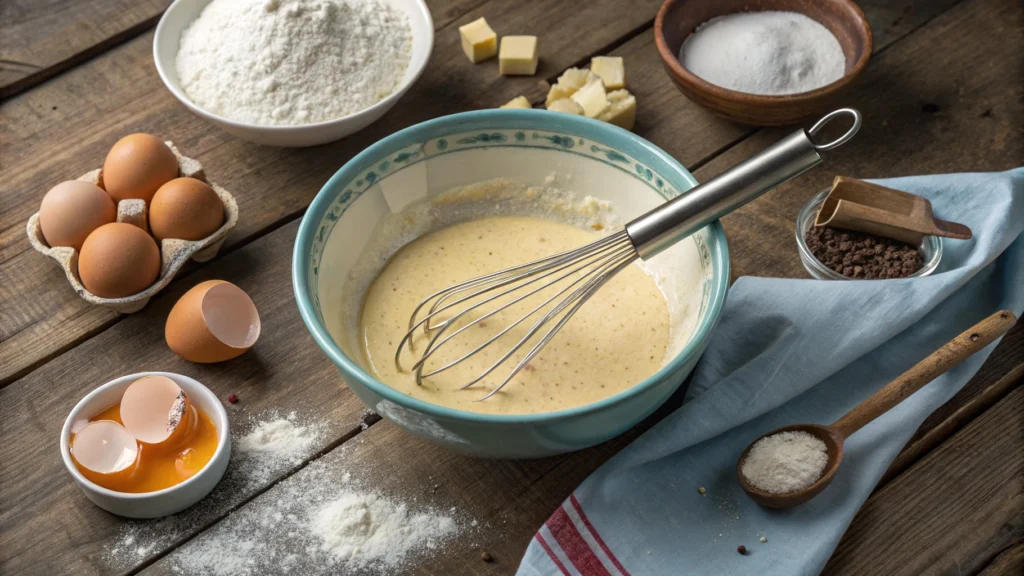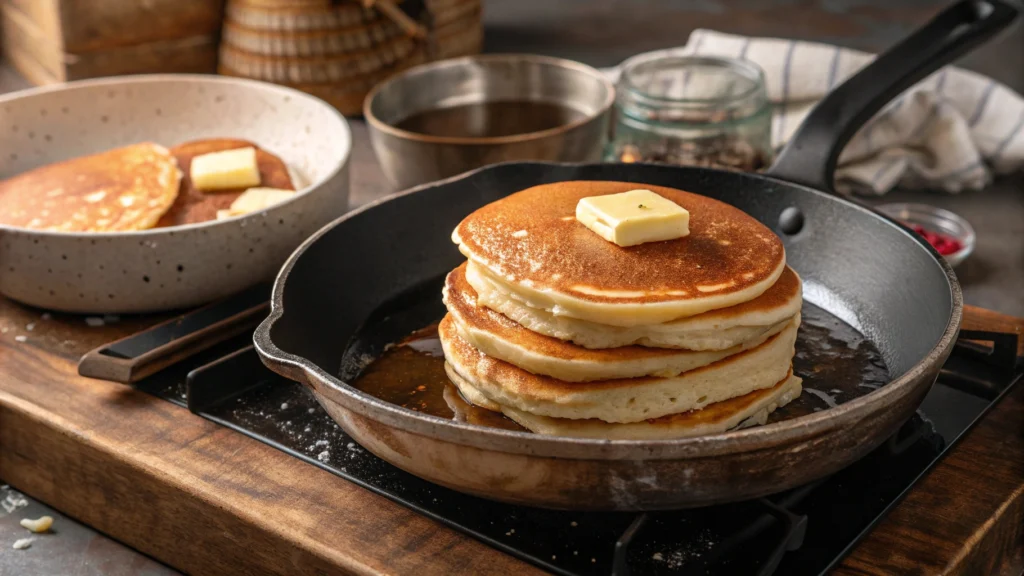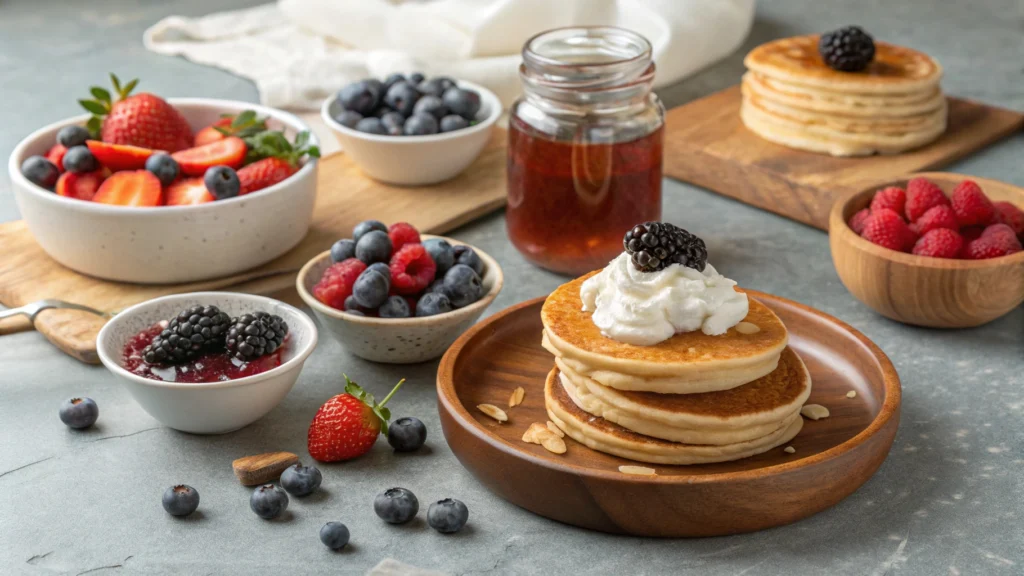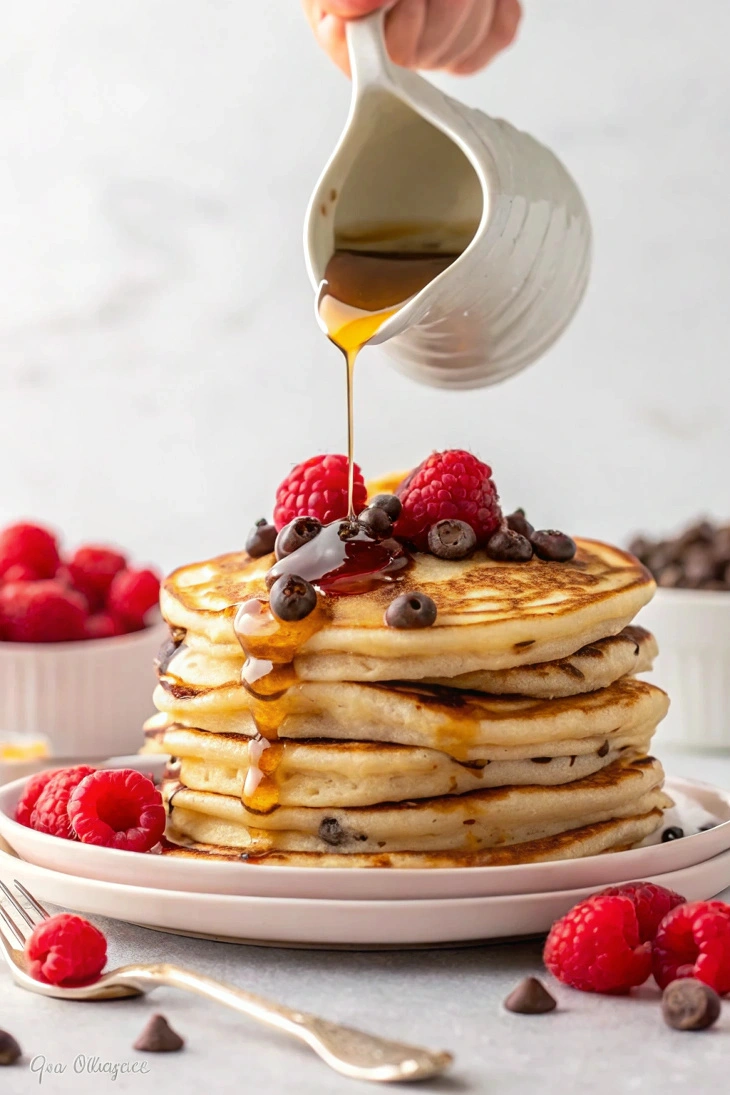Introduction
What is the secret to good pancakes? This age-old question has inspired breakfast lovers for generations.
Pancakes are a breakfast classic loved by millions worldwide. But not all pancakes are created equal, and anyone who has experienced a flat, chewy pancake knows the struggle of getting it just right. This article unravels the secrets to crafting pancakes that are fluffy, golden, and utterly irresistible. From choosing the best ingredients to mastering the perfect flip, we’ll walk you through everything you need to know. So, whether you’re a seasoned cook or a pancake newbie, prepare to take your pancake game to the next level!
Learn more about similar dishes in our Ultimate Pancake Recipe Guide.”
Table of Contents
Understanding What is the Secret to Good Pancakes
The Origin of Pancakes and Why They’re Loved Worldwide
Pancakes have a long and delicious history, with variations found in cultures across the globe. From American-style fluffy pancakes to French crêpes and even Japanese soufflé pancakes, the humble pancake has become a symbol of comfort food. What makes pancakes so universally loved is their versatility – they can be sweet or savory, simple or decadent.H3: Why Pancakes Have Stood the Test of Time
- Easy to make with minimal ingredients
- Quick and satisfying breakfast option
- Adaptable to endless flavors and toppings
Essential Ingredients for Good Pancakes

Making great pancakes starts with understanding the role of each ingredient. Each one contributes to texture, flavor, or fluffiness:
Key Ingredients and Their Purpose
- Flour: Forms the structure; all-purpose flour is ideal for most recipes.
- Milk: Adds moisture and contributes to the pancake’s soft texture.
- Eggs: Bind the ingredients and add richness.
- Baking Powder or Baking Soda: The leavening agents that make pancakes rise.
- Salt and Sugar: Enhance flavor; sugar adds a touch of sweetness.
The Importance of Ratios in Pancake Recipes
The right balance of wet and dry ingredients is critical. Too much liquid can make the batter runny, while too much flour can make pancakes dense. A 2:2:1 ratio of flour, milk, and eggs is a good starting point for most recipes.
The Importance of Choosing Quality Ingredients
Learning What is the secret to good pancakes? starts with high-quality ingredients.
The secret to making exceptional pancakes lies in the quality of the ingredients. Each component plays a crucial role in creating pancakes that are not only delicious but also perfectly textured. Here’s why fresh, high-quality ingredients make all the difference:
Freshness Equals Better Flavor and Texture
- Eggs: Fresh eggs whip up better, binding the batter and contributing to fluffiness. Stale eggs can lead to flat and dull-tasting pancakes.
- Milk: Using fresh milk ensures the batter has a creamy consistency, which translates to a soft, tender pancake.
Importance of High-Quality Flour
All-purpose flour is the go-to for pancakes, but not all brands are created equal. Choose a brand that is finely milled and unbleached for better results. Organic or specialty flours like whole wheat or spelt can also be used for a healthier twist.
Should You Use All-Purpose Flour or Specialty Flour?
Pros and Cons of All-Purpose Flour
- Pros:
- Versatile and widely available
- Creates light, fluffy pancakes when combined with leavening agents
- Cons:
- Lacks the unique flavor or nutritional benefits of specialty flours
Exploring Specialty Flours for Unique Pancakes
- Whole Wheat Flour: Adds a nutty flavor and fiber, ideal for health-conscious eaters.
- Gluten-Free Options: Almond or coconut flour for those with dietary restrictions, though adjustments in liquids are needed.
- Buckwheat Flour: Perfect for savory pancakes or those seeking a more robust flavor.
The Role of Additives and Enhancements
When and Why to Use Buttermilk
Buttermilk pancakes are a popular variation due to their tangy flavor and ultra-fluffy texture. The acidity of buttermilk reacts with baking soda, creating air pockets that make pancakes rise beautifully.
Should You Consider Adding Vanilla or Spices?
- Vanilla extract enhances the sweetness and aroma.
- A pinch of cinnamon or nutmeg can elevate the flavor, making your pancakes more memorable.
Mastering the Batter – The Real Secret (400 Words
How to Mix Pancake Batter Like a Pro
Creating the perfect pancake starts with the batter. The way you combine the ingredients can significantly impact the texture, fluffiness, and overall taste. Here’s how to master this essential step:
The Wet and Dry Method
- Step 1: Combine all dry ingredients (flour, sugar, salt, baking powder/soda) in one bowl.
- Step 2: Mix wet ingredients (eggs, milk, vanilla, melted butter) in a separate bowl.
- Step 3: Slowly add the wet mixture to the dry ingredients, gently stirring until just combined.
Avoid Overmixing the Batter
- Overmixing develops gluten in the flour, which can make pancakes dense and chewy.
- Aim for a slightly lumpy batter – it’s a sign that the mixture hasn’t been overworked.
Why Resting Your Pancake Batter Is a Game-Changer
Resting the batter is a crucial but often overlooked step. It allows the ingredients to fully combine and improves the pancakes’ texture and flavor.
The Science Behind Resting Batter
- During resting, the starch in the flour absorbs the liquid, resulting in a thicker batter.
- Air bubbles settle evenly, creating pancakes with a consistent texture.
How Long Should You Rest Pancake Batter?
- Standard Pancakes: Let the batter rest for 5–10 minutes for quick results.
- Fluffy Pancakes: Rest for 20–30 minutes for an extra rise.
- Cover the bowl with a kitchen towel or plastic wrap to keep the batter fresh while resting.
Secrets to Adding Ingredients Without Deflating the Batter
Incorporating Add-Ins Like Chocolate Chips or Blueberries
- Fold ingredients gently into the batter after it has rested to maintain the airiness.
- For berries, coat them lightly in flour to prevent sinking.
Adjusting the Consistency
- If the batter feels too thick after resting, add a splash of milk.
- For thinner pancakes, increase the liquid ratio slightly while mixing.
Pro Tips for Perfect Batter Every Time
- Use room-temperature eggs and milk to help the batter combine more smoothly.
- Add melted butter to the wet ingredients for extra richness.
- For even fluffier pancakes, separate the eggs and whip the whites before folding them into the batter.
Cooking Techniques That Make Pancakes Perfect
Choosing the Right Pan and Heat Level
The tools and heat setting you use can make or break your pancakes. Let’s explore how to set the stage for success:
Selecting the Best Pan for Pancakes
- Non-Stick Pans: Ideal for preventing sticking and ensuring an even cook.
- Cast Iron Skillets: Great for retaining heat but require proper seasoning to avoid sticking.
- Griddles: Perfect for cooking multiple pancakes at once, especially for larger batches.
Preheating Your Pan for Optimal Results

- A properly preheated pan ensures even cooking and prevents pancakes from becoming soggy.
- Heat the pan over medium heat for 3–5 minutes before adding any batter. Test the temperature by sprinkling a few drops of water onto the surface; they should sizzle and evaporate quickly.
Knowing When to Flip for Golden Perfection
Timing is everything when it comes to flipping pancakes.
Signs It’s Time to Flip
- Look for bubbles forming on the surface of the pancake. When they begin to pop, and the edges look set, it’s time.
- The underside should be golden brown before flipping. Use a spatula to lift the pancake slightly to check.
How to Flip Pancakes Without Breaking Them
- Use a wide, flat spatula to slide under the pancake gently.
- Flip with a quick, confident motion to avoid uneven cooking or batter splatter.
Managing Heat to Avoid Overcooking or Burning
Maintaining a Steady Temperature
- Too high of heat can burn the pancakes before the inside is cooked, while too low results in undercooked, pale pancakes.
- Adjust the heat as needed to keep it consistently medium or slightly lower for thicker pancakes.
The Role of Butter or Oil
- Use a small amount of butter or neutral oil to grease the pan before each batch. Butter adds flavor but can burn at higher temperatures, so consider a mix of butter and oil for the best results.
Tips for Consistency When Cooking Multiple Pancakes
Portioning the Batter
- Use a ladle, measuring cup, or squeeze bottle for consistent pancake sizes.
- Aim for about ¼ cup of batter per pancake for standard size.
Keeping Cooked Pancakes Warm
- Place cooked pancakes on a baking sheet in a warm oven (200°F) while you finish the batch. Avoid stacking them immediately to prevent sogginess.
Achieving the Ideal Texture – Fluffy vs. Thin Pancakes
The Science Behind Fluffy Pancakes
Fluffy pancakes are all about achieving the right balance between airiness and structure. The key lies in how you handle the batter and the choice of ingredients.
Key Factors for Fluffy Pancakes
- Leavening Agents: Baking powder or baking soda creates air bubbles that expand during cooking.
- Egg Whites: Whipping egg whites and folding them into the batter introduces extra air, making pancakes lighter.
- Batter Consistency: A thick batter holds air better, which leads to fluffier pancakes. Avoid adding too much liquid.
Pro Tips for Extra Fluff
- Replace regular milk with buttermilk, as its acidity reacts with the baking soda for added lift.
- Don’t overmix! A slightly lumpy batter retains air pockets better, contributing to fluffiness.
- Rest the batter for 20–30 minutes to allow the leavening agents to activate fully.
Adjusting Your Recipe for Thin, Delicate Pancakes
Not everyone prefers thick and fluffy pancakes. Thin pancakes, similar to crêpes, have their own charm.
Creating a Thinner Batter
- Use more liquid, such as milk or water, to achieve a runnier consistency.
- Reduce the amount of leavening agents like baking powder to limit puffiness.
Cooking Techniques for Thin Pancakes
- Use a smaller amount of batter and spread it thinly in the pan by tilting it in a circular motion.
- Cook on medium-low heat for even browning without overcooking.
Balancing Fluffy and Thin Pancakes for Your Preference
If you’re somewhere in between, you can adjust your technique:
- Use a moderate amount of batter and spread it slightly in the pan.
- Combine buttermilk with a bit of water for a thinner batter that still maintains a slight fluff.
Tips from Restaurants for Better Pancakes
Secrets Behind Restaurant-Quality Pancakes
Have you ever wondered why restaurant pancakes taste better? Professional chefs employ techniques that elevate pancakes from good to great. Here are the secrets to achieving that perfect restaurant-quality pancake at home.
Using Buttermilk for Superior Flavor and Texture
- Buttermilk is a favorite in many restaurants because its acidity reacts with baking soda, producing a light, fluffy texture and a slight tangy flavor.
- If you don’t have buttermilk, you can make your own by adding 1 tablespoon of lemon juice or vinegar to 1 cup of milk and letting it sit for 5 minutes.
Precise Measuring for Consistency
- Restaurants rely on precise measurements to ensure the batter has the perfect consistency every time. Use a kitchen scale for dry ingredients and a measuring cup for liquids.
- The ideal pancake batter is thick but pourable, resembling the consistency of heavy cream.
Enhancing Pancakes with Special Ingredients
Incorporating Club Soda or Seltzer Water
- Adding club soda or seltzer water to the batter lightens it by introducing air bubbles. This results in extra fluffy pancakes.
- Replace up to half the milk with club soda for best results.
Vanilla Extract and Spices for Depth of Flavor
- A splash of vanilla extract elevates the sweetness and adds a warm aroma.
- Adding a pinch of cinnamon, nutmeg, or even cardamom can create a flavor profile that’s uniquely yours.
The Professional Cooking Method
Preheating and Greasing the Griddle
- Restaurants ensure their griddles are evenly heated before cooking, maintaining a consistent medium heat for perfect pancakes.
- They also grease the surface lightly with butter or oil before each batch, wiping off excess to avoid soggy pancakes.
Flipping with Precision
- Professional chefs flip pancakes only once to avoid deflating them.
- They wait for bubbles to form and the edges to look slightly dry before flipping, ensuring even cooking.
Plating and Serving Like a Pro
Keeping Pancakes Warm Until Serving
- Restaurants use warming trays or ovens to keep pancakes hot without drying them out.
- At home, place cooked pancakes on a baking sheet in an oven set to 200°F until ready to serve.
Garnishing for Visual Appeal
- Add a pat of butter on top, drizzle syrup in a spiral pattern, and garnish with fresh fruit or powdered sugar for a picture-perfect plate.
Creative Additions to Upgrade Your Pancakes
Transforming Pancakes with Flavorful Add-Ins
While classic pancakes are delightful, adding a personal touch can take them to the next level. Whether you prefer sweet or savory, these creative additions will make your pancakes unforgettable.
Popular Sweet Add-Ins
- Chocolate Chips: A family favorite, chocolate chips melt into the batter, adding pockets of sweetness.
- Fresh Berries: Blueberries, strawberries, or raspberries bring a burst of freshness and color to each bite.
- Cinnamon Swirl: Mix cinnamon and brown sugar into the batter or create a swirl for a sweet, spiced twist.
Nutty and Crunchy Extras
- Chopped Nuts: Pecans, walnuts, or almonds add a satisfying crunch.
- Granola: Sprinkle granola into the batter for a textured pancake that’s perfect for breakfast enthusiasts.
Preheating ensures pancakes cook evenly without sticking. Looking for inspiration? Try our guide on Perfect Breakfast Recipes for Families.
Savory Pancake Ideas for a Unique Twist
Savory Additions to Try
- Cheese: Fold shredded cheddar, mozzarella, or Parmesan into the batter for cheesy goodness.
- Bacon Crumbles: Crispy bacon bits pair wonderfully with maple syrup, creating a sweet and savory combination.
- Herbs and Spices: Add chopped chives, parsley, or even a pinch of garlic powder for a gourmet touch.
Incorporating Vegetables
- Zucchini or Carrot Shreds: Perfect for adding nutrients without overpowering the flavor.
- Corn Kernels: Ideal for cornmeal-based pancakes or a Southern-inspired twist.
Toppings That Elevate Your Pancakes
Sweet Toppings to Indulge In
- Syrups: Maple syrup is a classic, but try flavored syrups like caramel or berry-infused for variety.
- Whipped Cream: Add a dollop for a luxurious touch.
- Fruits: Fresh, roasted, or compote-style fruits enhance both the flavor and presentation.
Savory Toppings for a Hearty Breakfast

- Avocado Slices: A creamy and healthy addition to savory pancakes.
- Fried Eggs: Place a sunny-side-up egg on top for a complete meal.
- Hot Sauce or Salsa: For those who enjoy a kick of spice.
Common Pancake Mistakes and How to Avoid Them
Avoiding the Most Common Pancake Pitfalls
Even seasoned cooks can run into trouble when making pancakes. Here’s how to steer clear of the most common mistakes and ensure pancake perfection every time.
Overmixing the Batter
- The Problem: Overmixing creates too much gluten in the batter, resulting in dense and chewy pancakes.
- The Solution: Mix gently until just combined. A few lumps in the batter are perfectly fine and contribute to fluffiness.
Using the Wrong Pan or Griddle
- The Problem: A pan that’s too thin or unevenly heated can cause pancakes to cook unevenly or burn.
- The Solution: Invest in a non-stick pan or a well-seasoned cast-iron skillet. Preheat the pan over medium heat for even cooking.
Skipping the Resting Time
- The Problem: Pancakes may turn out flat or uneven if the batter isn’t allowed to rest.
- The Solution: Rest the batter for 10–30 minutes. This step helps the flour absorb liquid and allows air bubbles to form.
Cooking at the Wrong Temperature
- The Problem: High heat can burn the pancakes’ exterior while leaving the inside undercooked, while low heat can result in pale, gummy pancakes.
- The Solution: Use medium heat for an evenly cooked, golden pancake. Adjust as needed during cooking.
Overloading the Batter with Add-Ins
- The Problem: Too many chocolate chips, berries, or nuts can weigh down the batter and cause uneven cooking.
- The Solution: Add extras sparingly, folding them gently into the batter right before cooking.
Flipping Too Early or Too Late
- The Problem: Flipping prematurely causes the batter to spill, while flipping too late can burn the pancake.
- The Solution: Wait for bubbles to form and pop on the surface, and check that the edges look set before flipping.
Frequently Asked Questions Answered
FAQs About Making the Best Pancakes
Addressing common pancake-making questions helps clarify techniques and ensures consistent results. Here are the answers to some of the most frequently asked questions.
What is the key to making the best pancakes?
The key to making the best pancakes lies in using fresh, high-quality ingredients and mastering the batter. Key steps include:
- Mixing the batter gently to avoid overdeveloping gluten.
- Resting the batter for at least 10–30 minutes to improve texture.
- Using medium heat and flipping at the right time to achieve golden perfection.
How do restaurants make pancakes so good?
Restaurants achieve better pancakes by employing specific techniques, including:
- Consistent Batter: Using precise measurements for a uniform texture.
- Special Ingredients: Adding buttermilk or club soda for extra fluffiness.
- Professional Cooking Tools: Cooking on preheated, well-oiled griddles ensures even heat distribution.
- Perfect Timing: Flipping pancakes once bubbles pop and edges set for consistent doneness.
What is the secret to a fluffy pancake?
The secret to a fluffy pancake includes:
- Using leavening agents like baking powder or baking soda.
- Incorporating buttermilk for a chemical reaction that creates air pockets.
- Resting the batter to allow the leavening agents to fully activate.
- Optionally whipping and folding in egg whites for an ultra-light texture.
How long should I let pancake batter rest?
Resting pancake batter is essential for optimal texture.
- Quick Rest: 10–15 minutes to allow the flour to hydrate.
- For Fluffy Pancakes: 20–30 minutes to let the leavening agents activate and create air bubbles.
- During resting, cover the bowl with plastic wrap or a kitchen towel to maintain freshness.
Part 10: Conclusion – The Secret to Good Pancakes Revealed (300 Words)
Recap of Key Points for Perfect Pancakes
Mastering the art of pancakes might seem simple, but the journey from good to great lies in the details. By now, you’ve learned the key secrets that separate mediocre pancakes from those that are fluffy, golden, and irresistible. Let’s summarize the essential tips:
- Ingredients Matter: Use fresh, high-quality ingredients for the best flavor and texture.
- Master the Batter: Mix gently, avoid overmixing, and always rest the batter for fluffier pancakes.
- Cooking Techniques: Preheat your pan, use medium heat, and flip pancakes with precision.
- Restaurant Secrets: Add special ingredients like buttermilk or club soda for enhanced fluffiness.
Encouragement to Experiment and Find Your Own Secret
Now that you know the basics, don’t be afraid to experiment. Add your favorite ingredients, adjust recipes to suit your taste, and try different cooking methods. Whether you prefer traditional fluffy pancakes or thin, crêpe-like creations, there’s a recipe out there that’s perfect for you.
Make Pancake Time Memorable
Pancakes are more than just a breakfast staple – they’re a chance to create special moments with family and friends. Whether you’re flipping pancakes for a weekend brunch or exploring creative toppings for a fun dinner, the process is as enjoyable as the result.
Start Your Pancake Journey Today!
With these tips and tricks, you’re well-equipped to make pancakes that everyone will rave about. So grab your ingredients, preheat your pan, and get flipping. The secret to perfect pancakes is now in your hands – make every batch a masterpiece!

